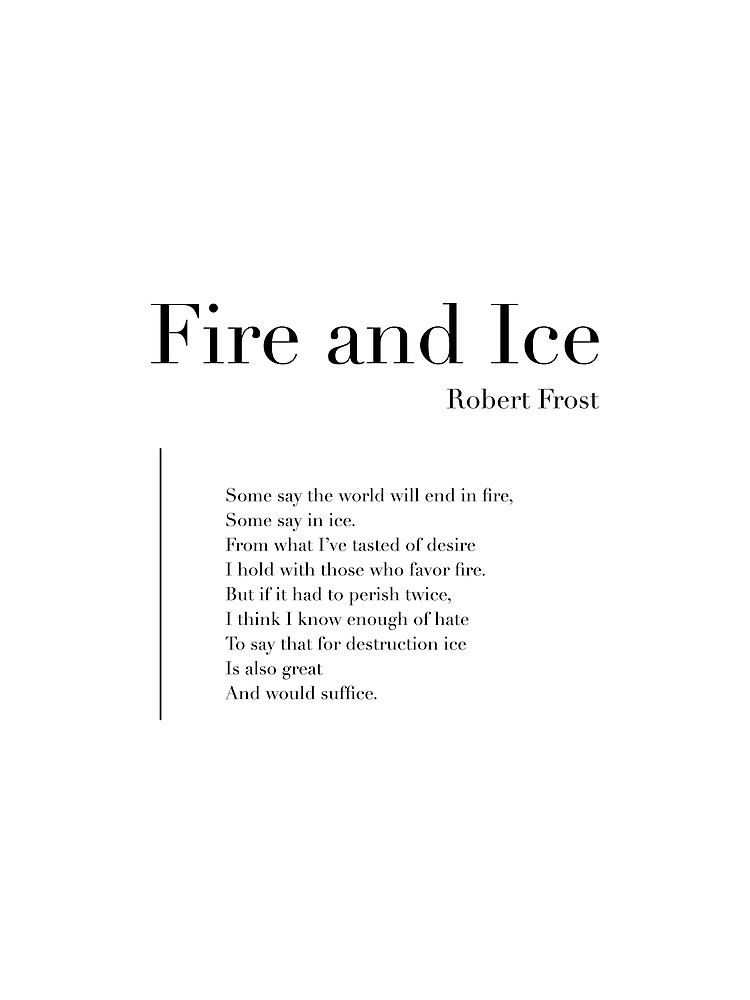Teacher’s Summary: In this thoughtful essay, a student delves into Robert Frost’s poem ‘Fire and Ice,’ exploring its profound themes and intricate poetic devices. The analysis begins with an understanding of the poem’s apocalyptic imagery and extends to a deeper interpretation of fire and ice as symbols for desire and hate. The student reflects on personal experiences with these emotions, illustrating how Frost’s work resonates on a personal level. The essay highlights the use of imagery, symbolism, rhyme, rhythm, and structure, demonstrating how Frost’s concise language delivers powerful messages about human nature. This engaging exploration encourages readers to appreciate the complexity and impact of poetry in expressing deep-seated truths about our emotions and relationships.
Robert Frost’s Fire and Ice: A Journey Through Chilling Verses
When my English teacher first handed out Robert Frost’s poem “Fire and Ice,” I’ll admit, I was a bit confused. It’s so short – just nine lines! How could we possibly spend an entire class discussing it? But as we dove deeper, I realized there was way more to this tiny poem than meets the eye.

The Surface: End of the World Scenario
At first glance, “Fire and Ice” seems to be about the end of the world. Frost presents two options: the world will end in fire or in ice. It reminded me of all those apocalyptic movies I’ve watched, where Earth faces destruction by either burning up or freezing over. I later learned that this idea wasn’t just Frost’s imagination – scientists of his time, like Harlow Shapley, actually believed the world might end in one of these two ways.
Digging Deeper: The Power of Human Emotions
But here’s where it gets interesting. As we discussed the poem in class, I realized Frost wasn’t just talking about literal fire and ice. He was using these elements as symbols for powerful human emotions. Fire represents desire, while ice stands for hate. This got me thinking about my own experiences with these feelings.
I remembered a time when jealousy (a form of desire) almost ruined my friendship with my best friend. It was like a fire, burning hotter and hotter until I couldn’t think straight. On the flip side, I’ve seen how hate can freeze people out, making them cold and distant. It’s like Frost is saying these emotions are so strong, they could destroy our world – or at least, our personal worlds.
Poetic Devices: The Tools of the Trade
Our teacher then had us look at the poetic devices Frost used. At first, I thought, “Ugh, more technical stuff.” But as we went through them, I started to see how these devices made the poem more powerful:
- Imagery: The vivid pictures of fire and ice really stuck in my mind.
- Symbolism: Fire as desire, ice as hate – it’s so simple yet so effective.
- Rhyme and Rhythm: The poem has this sing-song quality that makes it easy to remember, kind of like a nursery rhyme. But instead of teaching us about farm animals, it’s teaching us about destructive emotions!
- Structure: The way the lines are arranged, with some longer and some shorter, actually emphasizes certain ideas. I never would have noticed that on my own.
Personal Connections: Frost’s Words in My World
As I thought more about the poem, I started seeing examples of “fire and ice” everywhere. There was the heated argument I overheard between my parents last week – definitely some “fire” there. And the cold shoulder my sister gave me after I borrowed her sweater without asking? Total “ice.”
It made me realize that these intense emotions are a part of everyday life. Frost isn’t just talking about the end of the world – he’s talking about how these feelings can end relationships, friendships, and even change who we are as people if we’re not careful.
The Bigger Picture: More Than Meets the Eye
What I love most about this poem is how it packs so much meaning into so few words. It’s not just about the end of the world or even just about desire and hate. It’s about the power of human emotions and how they can build or destroy our relationships and our lives.
This experience has changed how I read poetry. Now, instead of just looking at the surface, I try to dig deeper. What is the poet really saying? How does the way they say it add to the meaning? It’s like being a detective, searching for clues in every word and line.
Conclusion: A New Appreciation
Before this class, I probably would have read “Fire and Ice,” thought “That’s neat,” and moved on. Now, I see it as a powerful statement about human nature, wrapped up in a deceptively simple package. It’s made me more aware of my own emotions and how they affect my relationships.
Poetry isn’t just about rhymes and pretty words. It’s about expressing complex ideas in ways that stick with us. Frost managed to do that in just nine lines – and that’s pretty amazing. The next time someone tells me poetry is boring, I’ll definitely have something to say about that!
Work Cited:
- Frost, R. (1923). New Hampshire. Henry Holt and Company.
- Parini, J. (1999). Robert Frost: A Life. Henry Holt and Company.
- Pritchard, W. H. (1984). Frost: A Literary Life Reconsidered. Oxford University Press.
- Thompson, L. (1966). Robert Frost: The Early Years, 1874-1915. Holt, Rinehart and Winston.
- Cambridge University Press. (2001). The Cambridge Introduction to Robert Frost.